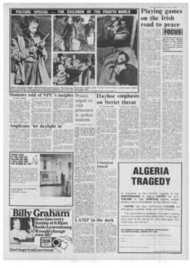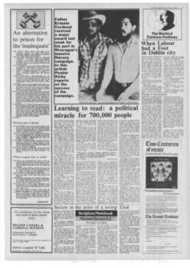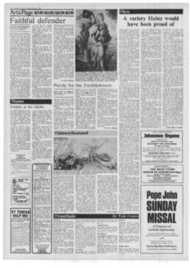Page 6, 31st October 1980
Page 6

Report an error
Noticed an error on this page?If you've noticed an error in this article please click here to report it.
Tags
Share
Related articles
The Test Of An Exciting Story Is It Good To Read Aloud?
A Time For Singing
Wordless Enchantments
Children's Choice By Isobel Quigly Living In God's Family...
Children's Bookshelf
IN THIS selection of stories and poems to be read aloud, by Shona McKellar (Evans, £4.25), All the year round is one of those rather far-fetched ideas in book production — stories and poems grouped by the month. Wintry ones for January and February, spring-like ones in April, hot ones for August, autumnal ones for October, Some are by wellknown writers (James Reeves, Joan Aiken, Ruth Ainsworth), many by unknowns.
Sara Coleridge's "January brings the snow, Makes our feet and fingers glow", familiar in my school days, starts it off. A story about skiing and sheep-rustling in the snow ends it, in December. It is aimed at the 5-7 year old, but sonic of the stories would do well for older children, It is pleasantly produced and contains some attractive, half-forgotten things, as well as new ones.
EDITED by Eleanor .Doan A child's treasury of verse (Hodder and Stoughton, £5.95), is American and contains a good deal of American verse by writers little known to us here. The poems are grouped under headings and some pretty line drawings — a little sentimental but quite acceptable, I'd say — divide them and cavort around them.
Some of the categories are "Adventure", "Character", "Favourites", "Fun and Nonsense", "Happy Memories", "Our Wonderful World", "Talking to God" ... and there are many more, twenty in all.
As with Bible stories, so with poetry anthologies: of course they're better to have than not to have at all. But I'm not sure what particular purpose this one, pleasant though it is, really serves.
-A fable is a story with a moral ... Fables, you see, are not intended merely for entertainment. They contain a lesson for us," So says Jan Knappert, who has spent many years collecting folktales from Africa and the Far East, in his preface to his Fables from Africa (Evans, £4,75), Most African fables are about animals — or rather, about animals showing human qualities and feelings and ideas. In other words, like Aesop's animals, they are human beings in disguise.
This is a rich little book, attractively produced, with a modern map of Africa to help one identify what comes from where, and very effective penand-ink drawings by Jeroo Roy.
The collector and writer of the tales is a lecturer at the School of Oriental and African Studies at London University and an authority on African languages and cultures.
Isabel Quigly
blog comments powered by Disqus











